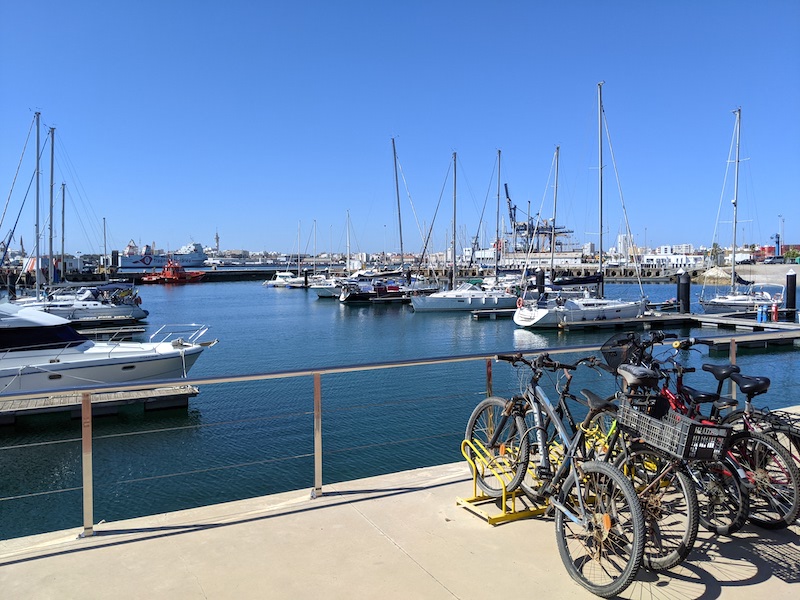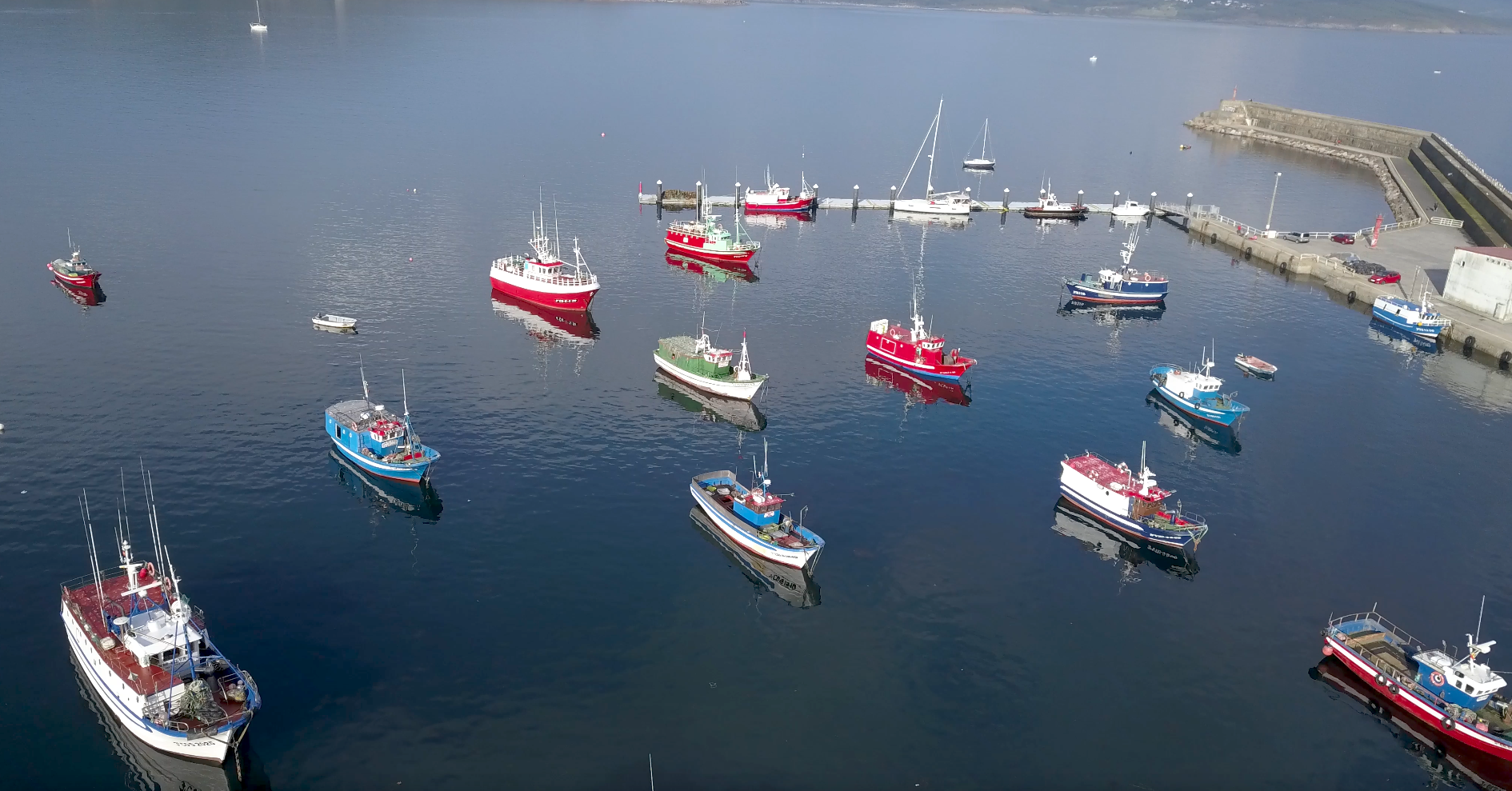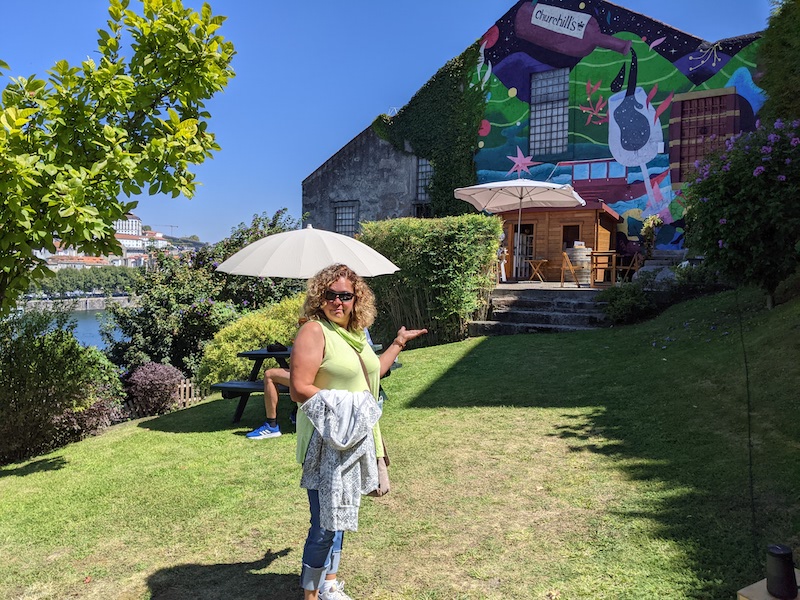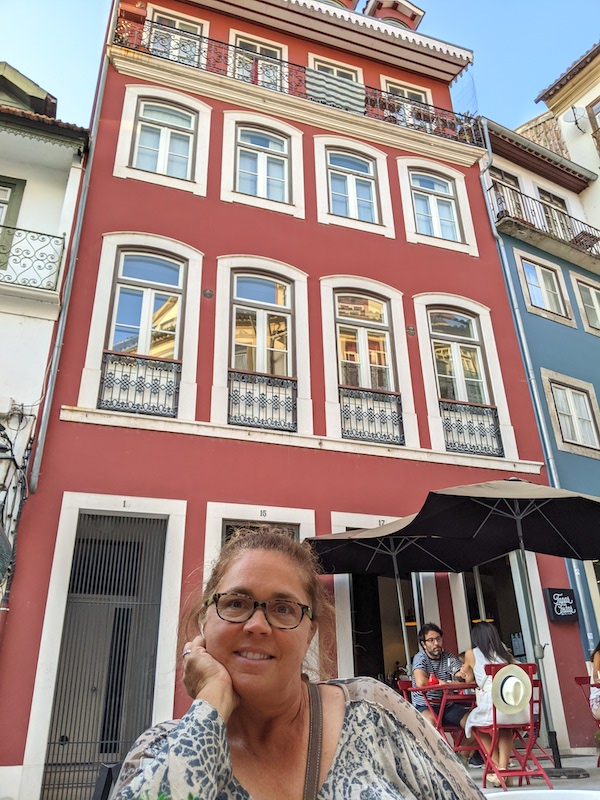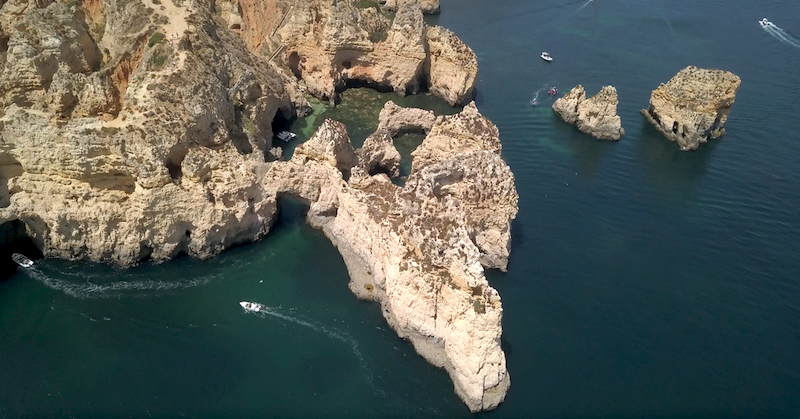Ever get that feeling that you are spinning your wheels? Like, as much as you try, you can’t move forward? We had just finished our Covid bubble embraces with Dan, Don and Shelly at Portosin. It was time for our last big push before our haulout in a week. The sky was dark and threatening to rain, but we needed to make progress. We shoved off the dock at the Real Club Nautico. As lines and fenders were getting stowed in lockers, we quickly got stopped in our tracks. A row of floats had been placed across the harbor entrance. At the far end, a skiff with several people plus a diver were busy handling lines and moving equipment. At the same time, I noticed a distant voice on the breakwater yelling and waving their hands. Were they trying to get our attention? As we approached closer, it was clear there was a line on the surface strung between the floats, blocking any vessel movement. At the skiff end, a narrow gap remained with barely a single boat’s width between them and craggy concrete forms angling down into the depths from the breakwater. Karen got on the VHF radio and tried to call them. I did my best to send a confused hand signal to them. Instead, they started motioning us to run the gap. There was no way we’d have any part of that. First, the diver was randomly disappearing from the surface, presumably to the sea floor. Where he would surface next was anyone’s guess. Second, we didn’t know the depth so close against the breakwater. The whole situation was appalling. Here was a harbor with at least 50 pleasure boats, and possibly as many commercial fishing boats, including several deep sea craft, and these guys were blocking essentially any movement in and out. The yeller onshore kept up his antics, and the skiff boys continued to insist there was enough width and depth. Regardless, we knew one thing for sure. If we ran aground or, worse, struck a diver, it wouldn’t matter what some bystanders said was safe. It would be our neck on the line. Another local fishermen was speeding back into the harbor, up on a plane, and nearly struck the float line before being waved off. Finally, we were able to reach the marina on the radio. They sent one of their launches out to meet us, talk to the skiff people, and get them to move their gear over so we could safely exit the harbor. We never found out what they were fishing for. I’m all for supporting a person busily putting fish on the table at home, but I draw the line when they put others at risk and cause a navigational hazard.
Continue reading “Good Vibes, Ep. 173”Bank Deposits, Ep. 172
I will be the first person to admit that we are extremely fortunate to partake in a lifestyle of our own choosing. While Karen and I worked very hard throughout our careers, watched our spending carefully and put a lot of our own sweat equity into projects instead of paying someone else, we owe our good fortune in this last quartile of our life to many people and events outside of our control. And to simple bum luck. I remember a late night drive home many years ago, nodding off long enough to cross the median and waking up just in time to pull out of the way of oncoming traffic. All those diapers my Mom changed, the shuttling to soccer and baseball practices, the fresh baked cakes for my birthdays – all of that could have been for not if I had awoken a split second later. We all have these inflection points in our timeline of life – tectonic, primal, retrospective. Karen and I had a very good friend develop cancer 15 years ago. She was fantastically athletic, her (and our) kids were still quite young, she looked like the picture of health – it did not make any sense. These landmark events can drive focus and block out the noise. Left with a clear signal, this is when I believe we can gain back control in our lives. For me, the signal was crystal clear. Our kids were getting older, my aptitude at navigating corporate politics was waning, my Dad had just passed, our nest egg was secure, and my health, while not as stellar as Emmy’s, was the best it had ever been. So I quit. And eventually so did Karen. We purposely didn’t call it retirement. I have always resisted labels as they quickly lead to stereotypes and, with them, dwindling opportunities to be the unique person that is you. Instead, we called it a sabbatical. But people still inquire, directly or subtly, what we do for work. You don’t fully comprehend what an identity center “work” is until you stop working. To be fair, for some, their work is their identity and for good reason. They are masters of their craft and their identity is rightfully intertwined with their work achievements. There are the Nobel Laureates, but also a good many grade school teachers, fire fighters, car mechanics, family counselors, doctors, etc.
Continue reading “Bank Deposits, Ep. 172”Friendship and Foot Travel, Ep. 171
How does a highly social species such as ours social distance from each other? As it turns out, not very well. You don’t need to be a sociologist to realize that with few exceptions, we thrive on the company of other human beings. Over 80% of the U.S. population lives in an urban area, and the trend is steadily increasing. On the prairies of early American settlement, we would flock to the saloon, the church, the school to share stories and re-invigorate our spirit. It’s why today we collect in corner cafes, on park benches, at the water cooler. It’s no wonder that solitary confinement is a form of human punishment. Would a rock concert be as fun if you were standing alone in the audience? It’s no surprise that we don’t take well to distancing ourselves. Karen and I often chide each other that while it’s been great to be with the one you love through the last two pandemic summers, we greatly miss the company of friends and family.
Continue reading “Friendship and Foot Travel, Ep. 171”Everyday Commerce, Ep. 170
Table wine has to be one of those all time great pleasures of adulthood. It goes magically well with all sorts of food. It can be enjoyed by itself or with a variety of cheeses. By its very nature, it encourages you to slow down and enjoy the moment and the conversation with friends. It’s a porthole into the local culture of a distant land. It can transport us back to a simpler time of ox carts, oak barrels, and eating al fresco style at a long wooden table with family. It carries with it all of the romance and practicality of farm-to-table dining. My parents would enjoy a glass of wine most nights with dinner, and so it wasn’t a surprise for me to imbibe as an adult, especially as Karen and I started to explore our local Northern California surroundings. But then one day a friend put a glass of Port in front of me and I ran for the hills. It was like a first taste of beer or wine. You nearly gag on the stuff and wonder what the fuss is all about. By the time Karen and I sailed Sea Rose into the harbor of Porto, I had moved beyond the gagging stage, and had a relatively neutral relationship with the wine derivative. Yet, few people come to Porto and walk away with an unaltered view of the nectar.
You have to be careful not to overindulge, and on a hot summer day it’s difficult to resist picturing any liquid as a refreshment. Karen had booked two Port tastings during our visit, and we set out tromping through the narrow streets and across an iconic iron-girded bridge to the other side of the Douro river, technically not part of Porto proper, where all of the Port houses were located.


Our first stop was Calum. There are a number of prominent options next door to each other, with vast tasting rooms and comprehensive cellar tours conducted in multiple languages by well-appointed guides. Calum was clearly corporate money, run on a schedule that vied for Swiss-watch accuracy. This was no family run affair with grandpa coming out of the vineyard on his aging John Deere to balance greeting you and chasing away the chickens and barn dogs. Not that corporate was all that bad. Instead of siting on hay bales, we sunk into an ultra soft couch in a converted stone-arched interpretative center and alternated between Port varietals and extra orders of chilled water. Jet-setting 20-something Europeans had to weigh sitting on a couch too-close-for-Covid with an American couple, or hustle along to the next house. We were not prepared for the distractions of an air-conditioned tasting room, and soon found ourselves hustling along as well for our next appointment, along side streets and past noisy construction sites. When it was clear we weren’t going to make it to Graham’s Port Lodge in time, we stopped to catch our breath in front of a small sign marking Churchill’s Garden Bar. We had stumbled into a garden oasis with terraced orchards descending to the river, coincidentally run by a family member of Graham’s that had decided to strike out on his own. No nepotism for this gent, apparently! It’s hard not to like a disruptive entrepreneur. And it was hard not to like Ports ranging from rubys, tawnys, and rosés in the shade of an orchard, close enough but separate from the hub-bub of downtown Porto.
We weren’t the first to discover this oasis, as a tour bus soon pulled up outside and we were politely reminded of our agreement not to monopolize the picnic table all afternoon. It was a good thing, as a post Port tasting siesta was dangerously approaching. Along the waterfront back in town, replicas of the traditional old wooden boats called rabelas were lined up properly along the river bank as if they were still waiting to use the wind and current to run wine barrels up and down the river as they used to do as far back as the 10th century until mankind threw a curve ball by introducing dams and locks along the Douro in the 1970’s.

But Porto is much more than a city plying its Port trade. If you can manage the sometimes precipitous street climbing reminiscent of Lisbon or San Francisco, you are rewarded with such gems as the Santo Ildefonso Church, with a tiled exterior shout out to the Baroque era. Nestled in between all of the cathedrals and plazas are street musicians serenading you along the way to a tempting potpourri of restaurants ready to re-energize you for the start of part two of the European day, which commences with dinner anywhere from 8-10pm. Alas, Karen and I had an early start in the morning; we’d have to trust the 20-somethings to carry the torch for us.

The tide was scheduled to turn in our favor and hit peak ebb at daybreak, giving us plenty of incentive to raise the anchor and be on our way, as we pushed north out of Portugal. We were bound for the Spanish region of Galicia, occupying a little time-out style corner of Spain in the extreme northwest of the Iberian peninsula. Most people think of Spain’s prominent cities – Madrid, Barcelona, Valencia – but tucked away in this corner just north of Portugal is Galicia where we were told several extensive river systems ran deep into the interior, providing tantalizing protection from the tempestuous Atlantic. We had developed an expectedly deep fondness for Portugal, a country that holds its charms close, almost secretively, unlike the big bullhorns of Mykonos, Ibiza, and the Amalfi. Jutting out into the Atlantic as it does, we would without a doubt be back.

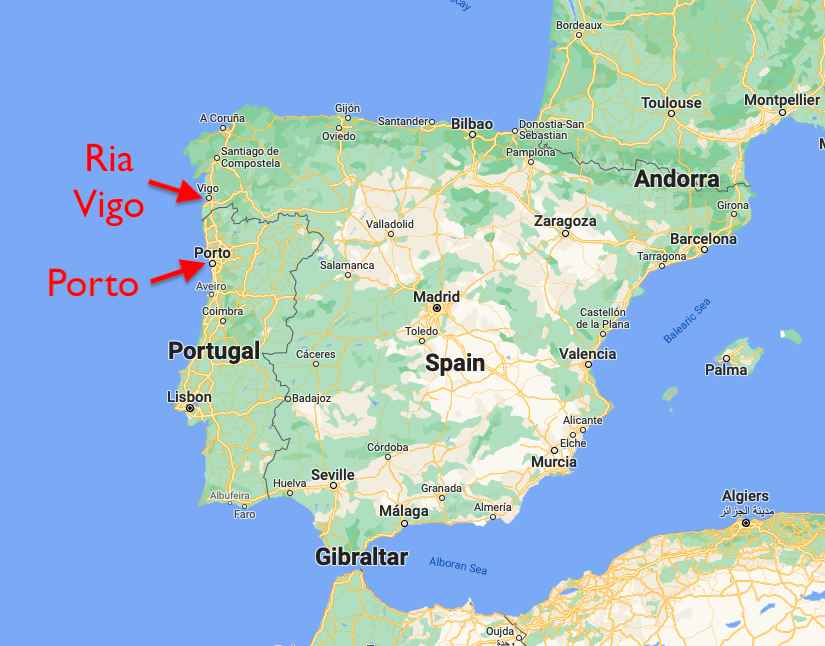

After being flushed out of the Douro River, we had 70 miles in front of us before reaching the first of the Galicia rivers, named Ria Vigo, a distance well within our wheelhouse after our earlier long strides up the coast. After passing the industrial port of Lexioes, with refineries juxtaposed with the fading charms of Porto in the distance, a light breeze developed from astern, tempting us to set our sails. But this rugged Portuguese coast with a reputation full of nasty weather had yet to lash out at us. Only a steady long-period swell rolling in from offshore reminded us we were no longer in the Med. OK, and also the clouds and threatening rain. The Galicia region, along with the northern Spanish coast stretching east to France, is nicknamed Green Spain for a climate that is closer to Ireland and the UK than the more well known arid interior of Spain. Warm moist air blowing in from the Atlantic is halted by a ridge of tall mountains, leading to lush pasture lands and thick forests. Our indoctrination into Northern European weather would be kicking into gear shortly!
Our first stop on the doorstep of the Ria Vigo was the village of Baiona. In our style of sailing, where we are moving steadily and trying to see as much of this beautiful planet as we can in our remaining time on earth, every once in awhile you need a utility stop, and Baiona seemed like the ideal option. A large anchorage in shallow water protected by a long breakwater – with grocery, chandlery and self-serve laundry ashore – checked all of the boxes. By the end of the day, with the errands necessary to keep a cruising sailboat and crew shipshape completed, we peeled back a layer of this understated town to better educate and enrich our Galicia introduction. The Pinta, from Columbus’ fleet, returned to Baiona in 1493 and became the first ship with news of the American discovery. To be fair, it’s widely understood Columbus didn’t discover America, but more accurately introduced Europeans to the American continent. Vikings sailed across, and before them, migrants from Asia traversed the Bering Strait. In modern times, we made our own discovery in the evening, as we searched for a warm meal after a day of dinghying back and forth to shore in the persistent rain. Baiona was not a town to flash its wares along the waterfront. Visitors, the town seemed to insist, had to show more gumption. We discovered our prize hidden a block off the main drag down an alley only wide enough for pedestrians and hand carts – a treasure trove of tiny cafes and bars. It’s possible this place was overrun with tourists in July and August, but on this drizzly September weeknight, locals shook hands or shared hugs with the proprietor before saddling up to a high top, next to others that found comfort in their espresso, cigarette and furry friend at their feet. I will never grow tired of the small outdoor European cafe scene. With an entry fee as low as a euro or two, you are welcomed into a social embrace whose dimensions of time and tenor are entirely of one’s own choosing.
As we exited the anchorage the next morning, we couldn’t help noticing the wide variety of northern European flags flying from boats surrounding us. Heading into the northern latitudes at this late hour of summer, we didn’t know what to expect for boating company. If Portugal had been any indication, it would be pretty light. Yet here we were in the company of Swedish, Danish, German, British, French and one Norwegian boat. With the rain, and the lack of tavernas ashore, it wasn’t quite the social scene we had left behind in the Med, but it was reassuring to know we were not alone. A few boats also flew a similar flag on their port spreader, which we found out later was the Atlantic Rally for Cruisers (ARC) rally flag. This crossing of the Atlantic wasn’t set to start for another two months, but apparently people were taking extra time to explore on the way south to the rally’s starting point in the Canary Islands, or maybe they had had enough of the cold and wet of the north.
Our friends Eric and Rhonda would be joining us in a few days and we felt the need to start checking out the various Ria Vigo anchorages to optimize their time onboard. Pre-covid, Karen and I would regularly have guests onboard – life is so much richer with friends to share in the journey – but we do find socializing and daily trip planning to be at odds with each other. The visit tends to go smoother if we have pre-planned a rough itinerary and identified multiple options for overnight locations based on a variety of weather scenarios.
Along the northern shore of the Ria Vigo are a string of small anchorages with long beaches to entice one to swim and explore with their benignly ankle-high wavelets coming to rest gently on the sand. The first, Enseada da Barra, is tucked behind a headland, protecting it from the steady ocean swells that seem to work past islands and peninsulas here with every intention of rolling your boat from side to side and keeping you up all night. It wasn’t hard to find Enseada da Barra, as the headland had not one but four lighthouses marking its approach from the sea. Talk about redundancy!



We had been tipped off by other boaters that the Rias supported a robust muscle farming industry with numerous floating platforms anchored to the seafloor, making it challenging to navigate around them. These floating farms, called viveros, were indeed sprinkled along the near shore areas, and we approached as close as we safely could to examine them. But they did not impede our ability to navigate nor to enjoy the safety of these waters. Consequently, muscles are served at nearly all of the local restaurants, and we didn’t feel it was our place to criticize an industry that featured so prominently in the local economy with a menu item we would regularly order and enjoy locally. Here was a food offering that, unlike land-based farms that sometimes damaged the nearby sea life with fertilizer runoff, actually worked to positively clean the water with their filter-feeding physiology.

We settled for the night in the adjacent and curiously named harbor of Cangas with its own long sandy beach, tucked in behind a large muscle farm which helped to calm the seas even further. With so much muscle farming going on, and coastal waters rich in seafood, Cangas had its fair share of commercial fishing operations ashore. Yet like so many small towns in this region, work and pleasure seemed to easily co-existed, even thriving on each other. As a visiting tourist, there is a certain groundedness that comes with hearing the sounds and seeing the sights of day-to-day commerce in and amongst the shops and restaurants. I would like to also think that fishermen and women also prefer a bustling, local waterfront full of eager souls ready to order their fresh harvested seafood at local restaurants and grocery stores.

In the morning, we were up early to hop across to the namesake of this ria, the city of Vigo. Eric and Rhonda would be arriving later in the day, and the pre-arrival check list was growing rapidly. It was clear even before we approached the Vigo waterfront that commerce was priority one in this town. Massive working docks lined the shore. On one end, multiple car carriers tied up adjacent to a massive parking lot crammed with thousands of new passenger cars waiting for export. In the center of the waterfront were rows of dry docks and shipyards servicing large commercial fishing, research and tug boats. Next to them were a series of big refrigerated warehouses owned by Pescanova, one of the largest fishing companies in the world and the center of the Galicia canned fish industry. Finally, several tall container cranes loomed over the opposite end of the waterfront. For obvious reasons, we sought out a quieter alternative to overnight onboard Sea Rose, settling on Marina Punta Lagoa, nestled into a wooded knoll on the outskirts of town. The marina had plenty of space for us, with wide long docks and stout cleats. Our only challenge was on the communications front. We had been told to not expect much English in the Galicia region, and that was a very spot-on warning. No one answered our VHF call, and when a friendly man arrived by skiff to greet us, we got by with simple nods and hand gestures. Our usual list of questions on where to get fuel, buy groceries, do laundry, and eat out would have to wait for another time.

Even if we had been able to communicate, it wouldn’t have changed our odds of finding an open store on this Sunday. Our best option seemed to be back in downtown Vigo. Not wanting to rely on hand gestures with a taxi driver, even if one could be found on this day, we took Option B of lowering the dinghy and motoring across the harbor. A city of industry is not a tantalizing affair on a Sunday and Vigo was no exception. We settled on the first convenience store we could find that was open, with packaged meats of unknown expiration but the upside of fresh baked bread. Otherwise, Vigo looked like a city who had lost its tourism director after a few abandoned false starts along the waterfront. Still, our first glimpse of the Spanish Rias teased us with their lightly frequented beaches, curvaceous offshore islands, and the fortitude of commerce to lay before us the tasty bounty of the sea. We were on the cusp of a whole new adventure in this secret corner of Spain.

Gift Giving, Ep. 169
It seemed too good to be true. Ahead of us was the unforgiving coastline of Atlantic Portugal with its steep cliffs and deep ocean canyons. Yet for the next six days, the forecast was one of mild-mannered seas and gently cooling evenings. The notorious Nortada, the wind from the north that had us double checking the diesel in our tanks in order to brutally bash our way to windward, seemed to have left on vacation. Like the angelic girl of your high school dreams, momentarily still available to join you on the dance floor, timing was critical. Fresh from our land pursuits, we hopped back onboard Sea Rose and exited Marina de Cascais, pointing our bow almost exactly north on the ship’s compass to the first safe harbor of Peniche. We didn’t want to show any disrespect to the weather gods for handing us this unexpected gift.
It didn’t take long before Cabo da Roca, that westernmost point of continental Europe that we had seen by car, to first come into view. My worries about the treacherous rock-strewn shoreline full of whipped up white water were all for naught. You could practically water ski on these benign ocean scapes.

Portugal by Land – Bring Your Climbing Legs! Ep. 168
Before Karen and I dove deep into the sailing life, we’d frequently jump in the car and take to the road. Our adventures took us to stunning vistas in California’s Sierra Nevada, the Pacific Northwest, and all throughout the Northeast of the U.S. As beautiful as these excursions were, I’d find myself yearning to eventually find a watery overlook – sea cliffs, a lake, even just a mountain stream. There is something mystifying and transformative about the water. The sound it makes over pebbles or beach stones has the power to settle the most anxious mind. Sitting at the ocean’s edge, the water serves as a portal to another world; floating across the sea, there is nothing separating you from experiencing an entirely different culture and geography – whether you go there or it comes to you. On a road trip, I love these context switches.
Similarly, as much as we cherish our adventures at sea, full-time life onboard can at times feel a bit monochromatic. So, every once in awhile, we park the boat and head inland. With the long, skinny geography of Portugal, it is hard to go too far away from the sea, but still there are a lot of fantastic sites to visit.
Continue reading “Portugal by Land – Bring Your Climbing Legs! Ep. 168”Clear Air and Cosmopolitan Charm, Ep. 167
The anchorage at Sagres, with its semi-circular beach, felt like one of those fancy curved-back love seats, the ones with the high armrests. To each side of us was high protective cliffs, the water around us had soft little ripples like corduroy, as the wind blew gently off-shore, keeping the surface free of swells. Tomorrow’s forecast to tackle the west coast of Portugal looked even better than today’s, so we took it easy exploring this mariner’s outpost. At the point of land, a grand lighthouse stood watch over the tall headlands, making for a long range of light out to sea. Around its perimeter were the renovated remains of the 18th century Fortress of Sagres. It was flat as a pancake on the top of these headlands, with built in protection on three sides with the sheer cliff drop off. The designers only had to take into account a secure wall across the narrow land entrance.

What the Tide Bringeth, the Tide Taketh Away, Ep. 166
The Ria Formosa lagoon was so expansive, it felt like we were anchored on an inland lake, a lake with just a few hundred of our sailing brethren. Once we had backed down on our anchor and ensured that it was going to hold our floating home securely, I launched one of the paddle boards and started exploring around the anchorage. It quickly became apparent that despite being inland, the waters here were too chopped up to make paddle boarding safe, let alone enjoyable. It seemed like a constant line of high speed taxi boats were running from the ferry landing to the mainland, back and forth with reckless abandon. Before I embarrassed myself with a wobbly, on-a-constant-threshold-of-falling paddling experience, we opted to dinghy into shore and check out the scene on Culatra.

Crossing Borders and Bars, Ep. 165
With the warm Atlantic waters lapping at its door step, no city quite captures the essence of southern Spain like Cadiz. Aromas waft up from sidewalk-busting cafes leading to hundred year old trees shading cozy neighborhood squares. Majestic coastal fortifications once built to ward off marauding intruders now wrap pedestrians in a warm embrace, perched as they are high above the din of the city. Residents and Spanish tourists alike walk as if guided by deeply embedded cultural cues, as they seek out the most direct path to a siesta sponsored beach afternoon, towel and umbrella in tow.
I recognized very little of a city my parents insisted we visit on a quick vacation to Spain many decades ago. With only a handful of years under my belt, I remembered the name Cadiz, but painfully little else. Such is the curse of family trips with young children. Paradoxically, we struggle to remember now, cursed as our brains are with little room to store a lifetime of memories.
Continue reading “Crossing Borders and Bars, Ep. 165”Russian Roulette with Orcas, Ep. 164
On my first summer home from college, I found myself a bit behind on a search for a job. My high hopes to find a position in my field of engineering study had turned up empty. With just a year of advanced learning under my belt, it seemed like I was a charity case that no one wanted to take on. Before leaving for college, I had worked summers at a boat rental business in San Diego’s Mission Bay, far better than many of my other friend’s jobs working the fast food kitchen scene, but if I was going to have to revert to a mindless job, I wanted to try something different than the norm. I never liked to lean on friends, or more specifically, friend’s parents, but our family was connected to an executive at Sea World, and he was more than happy to line up a summer gig for me. When I showed up for work on the first day, I assumed I was going to be taking tickets or flipping over-priced theme park burgers. So you can imagine my surprise when I was told I would be a rotating crew member prancing around the park in a full-length costume of none other than Shamu, the iconic killer whale made lovable and non-threatening for all of the young children visiting the park. On one hour rotations, I would suit up, after spraying down the insides with deodorant, and walk around and pose for pictures with huge groups of little kids in tow. I’ll be the first to admit I’m not an extravert, but something fundamentally transformative happens when you dress up beyond recognition. You can be anyone you want and no one is the wiser. It was my summer acting sabbatical, and by far the funnest summer job I’ve ever had. After posing with me, little kids would tug the shirt tails of their parents for a stuffed Shamu toy or themed snow globe at the conveniently located adjacent store. And so it was good for business, before up-selling was really a thing. I’d hang up the costume at the end of the day, ride my bike an hour home, rest up and do it all again the next day. The not-so-subtle messaging for parents and kids was the undeniable charm, and dare I say cuddliness, of Shamu the Killer Whale. He might have a scary name, but if you could pose with him, buy him in a stuffed package, and watch a full-sized one leap out of the show tank and allow a trainer to stick his whole head in the giant mammal’s mouth, he’s not really that dangerous, right? Wrong!!
Killer whales, or orcas, as they are more appropriately named, have been known to injure or kill their trainers, a fact that Sea World was trying hard to play down. But yet, on the whole, they have largely been benign to humans, as people watch them safely from whale watching boats in popular sites like off Orcas Island in the Pacific Northwest. However, starting last summer, orcas started to attack boats off the Portuguese and Spanish Atlantic coasts, causing damage to sailboats in particular, and leading many boats to be towed to port for haul out and repairs. Orcas had visited boats in this region before, and in fact, they would commonly follow fishing boats that were netting their popular prey in these waters, the tasty tuna. But it was very rare for them to attack a boat. Yet, there were now regular reports of these ‘encounters’, as the scientists studying the matter would refer to the activity. Oddly, they had an affinity for sailboats; and, after swimming along next to the hull, they would turn more aggressive and push against the rudder, turning boats suddenly ninety degrees and causing injury to some skippers as the helm turned violently. They would often follow this up by biting at the rudder itself; and reports were coming in late last summer with pictures of boats hauled out and showing severely damaged rudders.
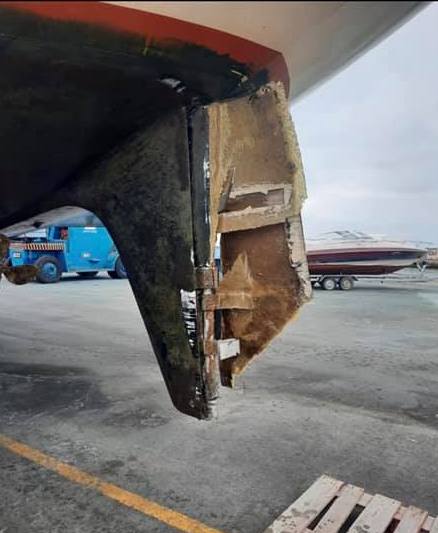
Our plans to leave the Med last summer had changed due to Covid, and while we stayed in Greece, we were still alarmed at the damage these orcas were doing. At one point last year the Spanish coast guard imposed a navigational restriction along the entire northwest coast of Spain for boats under 15 meters, which would have included our 12,6m Sea Rose. Reports were being gathered by a coalition of scientists called the Atlantic Orca Working Group, which showed ‘encounters’ from the northwest of Spain all the way down to Gibraltar. We hoped it was an anomaly last summer, but as sailboats started transiting the coast again this spring, reports started coming in again, with the most prevalent area for attacks being the stretch from Gibraltar to Cadiz, Spain.
As Karen and I made our way westward from Greece, we read with angst the accounts of other sailboaters that had been attacked. There were times when multiple attacks occurred in one week. It was easily the biggest source of stress we had, even more than the long multiple day passages we were enduring between islands. As we pushed west along Spain’s Costa del Sol, the stress level continued to increase, like a kettle ready to boil over. How were we going to get through this gauntlet? During an attack, the risk of injury was high, and if we had to be towed to an unknown port for repairs, that could put a halt to the rest of our season, and disrupt the plans of friends coming to sail with us.
Just two weeks before our planned passage between Gibraltar and Cadiz, sailboats were being struck almost every day. And no one, scientist or layperson, had any clear explanation why. Finally, a boater heading to Cadiz reported that they chose to stay tight against the shoreline, in water only 5-10m deep, with the theory that orcas don’t like shallow water. They had escaped orca-free. Indeed, most of the recent attacks were at least 5-8 nautical miles offshore. Then, another boater tried the same thing, providing a helpful GPS track of their entire route from Tarifa, just west of Gibraltar, hugging the cliffs and beaches along the 50 mile passage to Cadiz. The alternative we had been considering, of going far offshore and looping around to Portugal, seemed problematic as we had no way at that far distance from land and without a satellite phone to call for help if we were attacked. So, we latched on to the close-in-shore route. It felt good to have some kind of plan, instead of leaving the odds of an attack to chance, like a game of russian roulette.
As a warmup for our orca avoidance strategy, we cautiously entered the busy harbor of Gibraltar, with its iconic angled rock precipice. We knew it would be busy but we were not at all prepared for the mayhem that greeted us as we rounded the corner of Europa Point. The harbor was full of tankers and cargo ships, some moving, others appearing to be stationary, but then suddenly moving again. Fast ferries were running between the harbor and Morocco, just 10 miles south. Work boats, supply boats, and pilot boats were running back and forth between the big ships. It seemed clear that pleasure boats like ours were at the bottom of the pecking order, and we were expected to avoid all of the commercial traffic despite any legacy rules of navigation. Worse than the large cargo ships were the many slightly smaller tankers doing pirouettes as they rafted up to the large ships, handed over bulky fuel hoses, and resupplied bunker fuel to these beasts of the sea. One car carrier had a tanker on both sides, taking on fuel while looking like a gargantuan trimaran.
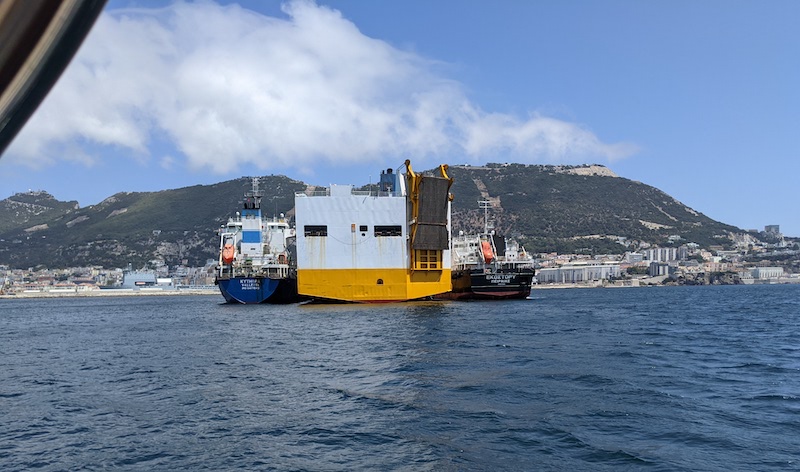
They were anchored so close together that as we nosed around the stern of these rafted ships, another supply tanker might just be barreling down in front of us, or overtaking us from the stern. It was all hands and eyes on deck. Adding to the message of commercial-boats-welcome-others-not-so-much, we headed to an anchorage off the beach at La Linea, joining a few other boats at a spot rumored to be illegal for small boat anchoring. Boaters here were prone to being swatted away by the maritime police despite it being marked as an anchorage on the chart. Gibraltar is known as a good re-supply area. Fuel is duty free here, which might explain the preponderance of bunkering operations in the harbor. But for us, we just needed to find a grocery store.
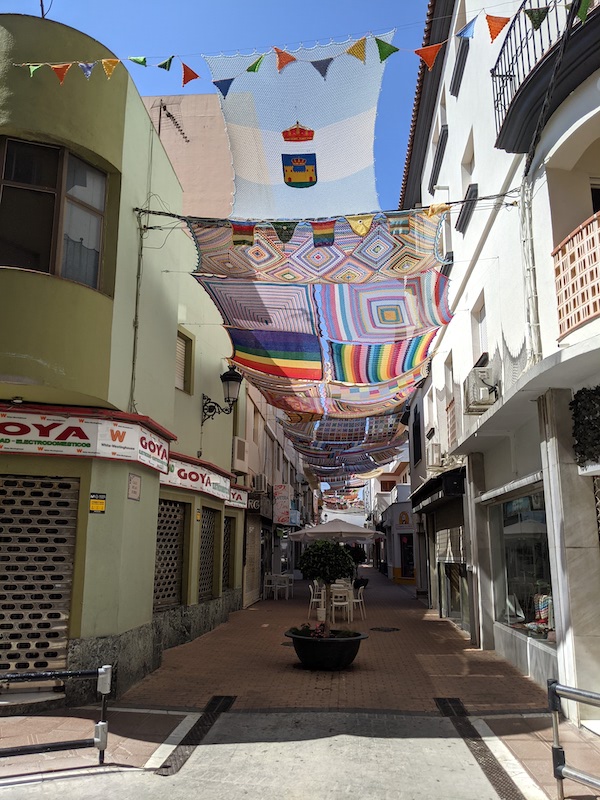
La Linea is technically part of Spain, and although we got lost on our walk to find a grocery store, we didn’t cross the line just five minutes south into the territory of Gibraltar. So close, yet so far!
With our stores replenished, we were left to debate the merits of staying on anchor at La Linea, with the threat of being asked to move in the middle of the night, or seeking out an anchorage across the expansive harbor. We chose the later, only to find out the anchorage we were headed toward also forbid anchoring, apparently because it was in a marine reserve area. With the amount of hydrocarbons being emitted by all of the big boats in this harbor burning putrid bunker fuel, the dirtiest fuel imaginable, it seemed like Gibraltar needed a lot more of these marine reserves. We were down to one bullet in the magazine, and that was the small harbor of Tarifa at the western end of Gibraltar Strait, requiring us to transit the Strait today … now, as dusk approached. The winds were uncharacteristically out of the east, making our westbound transit a bit more practical despite a strong eastbound current. Karen and I looked at each other and decided, with a combination of equal amounts bravado and angst, to go for it and run the Strait, even though we had already come 50 miles. Tarifa is a name you hear all of the time on the radio in these waters — ‘Tarifa Traffic’ is the radio handle that acts like the air traffic controller of vessel traffic through the Strait. The town also has a reputation for extremely high winds, with 40 knot blows not uncommon and a wind of at least 30 knots per day for 300 days out of the year. Hoping this would be one of the other 65 days, we raised our jib and motor sailed westbound close to the northern shore to get some relief from the counter current. As Tarifa started to come into view, we killed the engine and enjoyed 7 knots of boat speed with just the jib up. And just as quick, it wasn’t fun anymore. The wind speed hit 20 knots and we started to make a plan to furl the jib. Suddenly, I saw the anemometer shoot up to 38 knots. There it was, the 300 days per year statistic continuing to make its mark. I started cranking in on the winch to furl the jib and immediately the line became taut. Something was jammed. When you have high winds and can’t get the sail furled, it’s extremely dangerous. Rigging can break, sails can rip to shreds. Karen was trying to keep some tension on the jib sheet but the whipping of the jib was pulling the sheets out of her hands and slapping them mercilessly on the deck, with the jib itself snapping and cracking in the blow. We tried turning upwind slightly, but the furling line was still tight as a guitar string and we were headed directly for rocks on the north shore. I cranked the winch even harder, not sure what else to do, but fearing my actions might cause blocks, lines or furlers to explode into pieces under the load. Finally, I gave up and ran along the side deck to the bow, where the problem was clearly evident. As we started to furl the jib, slack sail material had caught the rolled up Code 0 halyard in its path, and tried to roll that line inside the jib. My cranking effort was about to do real damage. Back at the cockpit, we headed on a beam to the wind and let the jib out further, despite it cracking even louder in the wind, until it was free of its death grip on the Code 0 halyard. Sheets were snapping like a hundred school kids cracking their towels at once in a junior high school locker room. With the jib blowing away from the halyard, it furled up slowly and steadily, until the cacophony died down and we had the sails and lines all restrained and put in their place. We were both exhausted. The rocky northern shore kept looming closer and we breathed a sign of relief as we redirected Sea Rose under motor back westbound out the Strait.
In the fading light and reduced heart rate, Karen guided us into the anchorage at Tarifa, where a few kite boarders were just wrapping up their day of play in the high winds. We crept into the beach slowly to find a good anchoring depth, dropped the hook, backed down to make sure it was set, and then shut down the engine. The day’s navigating was now over, thank goodness.
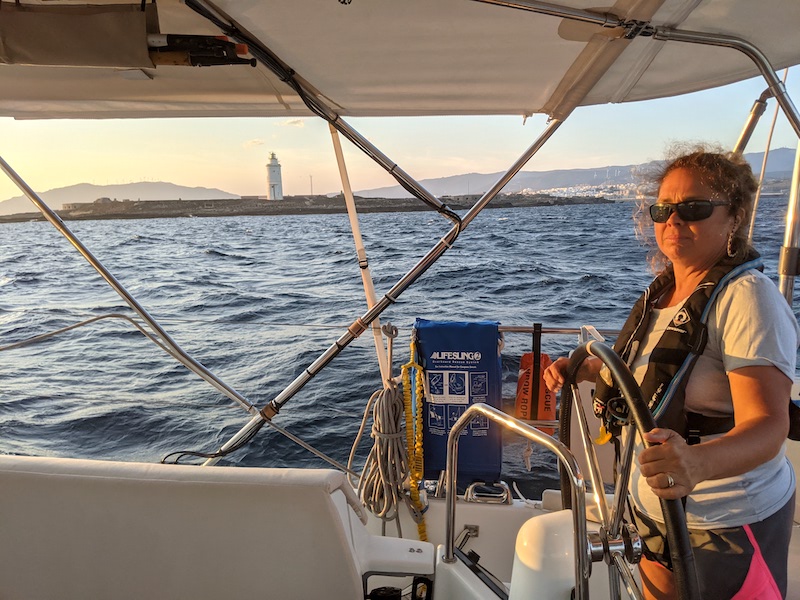

Tarifa is the southern most point of the European continent, and was the landing spot of the Moors as they took over the Iberian peninsula. All we needed to take was a quick dinner and flat bed. But we had been told by another boater about an excellent seminar on the orcas, recorded a few months ago by one of the lead scientists in the Atlantic Orca Working Group. It felt prudent to watch it before our run tomorrow through these orca-infested waters. There were a lot of theories about why the orcas started attacking sailboats, but the scientist Ruth Esteban, was hesitant without additional data to validate these theories. One that was most intriguing to me related to Covid 19 in a circuitous way. With fewer fishing boats and tuna nets in use since Covid, the orcas can’t hunt tuna in the same they used to. So they go after boats. Regardless, the working group’s suggestion if one were to have an ‘encounter’ was to furl sails, stop the engine, step away from the helm, and secure anything in the cabin that might come loose in a sudden movement of the boat. It was interesting to hear a scientist’s perspective, but in the end the video likely made us even more anxious.
In the morning, we posted a cheat sheet in the cockpit of what we would do if orcas approached us. I also mounted several cameras with various angles so that we could capture video to send to the working group. Karen constructed a detailed route in the chart plotter along the coast from Tarifa to Cadiz, keeping us in no more than 10-15m of water, while avoiding off-lying rocks and other hazards. And we discussed how we would handle watches. Without question, we would both be 100% dedicated to navigating until we were safely tied up in Cadiz. One person would be at the helm, the other up on the foredeck sweeping for shallows, other boats, and dorsal fins. This would allow the person at the helm to look down at the chartplotter as needed without worrying about hitting something. We agreed to wear our lifejackets all day and to switch positions every hour.
At the start, as we pulled up anchor at Tarifa with just enough morning light to see, it was somewhat anticlimactic. There was no wind, the water was flat, and the scenery tremendous. We never navigate this close to shore, but the upside is that we could enjoy the cliffs and rocks and beaches with clarity, as long shadows were cast upon the waterfront. When I took over at the helm, I found myself steering away from the coast and out to sea. I had to fight the subconscious thought that we were too close and could run aground.
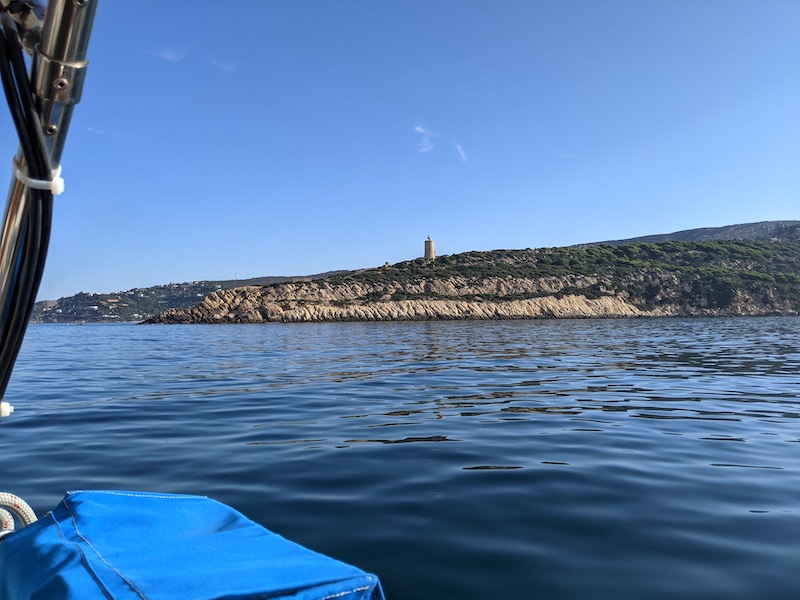
Back on the foredeck, I found my mind drifting off at times. As much as you try, it is hard to singularly focus on a task for an hour at a time. Watching for passing cars at a crosswalk is one thing, but staring for an hour for an errant driver is another challenge all together. Still, we stuck to our plan, while taking in the beautiful views of the coastline. Then a call came in on the VHF. A boater was trying to reach Tarifa Traffic. We huddled around the handset to hear them explain how they had been attacked earlier this morning by orcas. We tried to get a lat/lon on their position, but were unsuccessful. Hearing a firsthand account of an attack made us all the more concerned. The only bright side was the fact their call was a bit scratchy, indicating that they were some distance away from us. But the attack had occurred earlier in the morning, and their location at that time was unclear.
We approached the town of Barbate. The waters off of here had been a common area for attacks over the last few weeks, and boats that were disabled had been towed into the local boatyard. I could see in the distance the signature bright orange color of a search and rescue boat exiting the Barbate harbor entrance and heading out to sea at full throttle. We had not heard any calls on the radio, but it didn’t take much imagination to guess what they were doing.
We followed the indent of the coast at Barbate tightly. Strangely, small fishing boats were scattered all over the waters here, some fishing close into shore, others motoring out to fish in deeper waters. We came up behind another sailboat leaving the Barbate harbor, but soon we turned north to follow the inshore route while they headed out into deeper waters. Had they not heard the warnings, and recommendations of other boaters? When we were in the Medicane last year, I remember having the same feeling, as we headed north a safe distance away while a few boaters headed south right into the path of the storm.
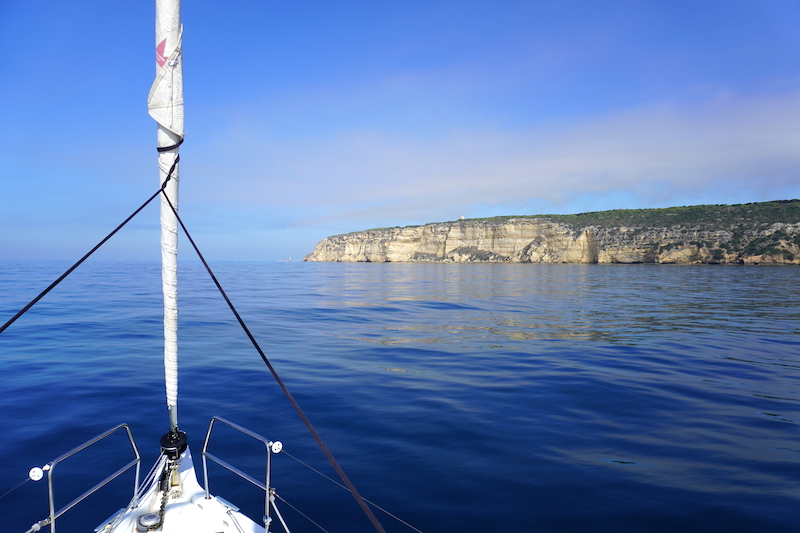
Off of Barbate is Cape Trafalgar, site of the historic Battle of Trafalgar during the Napoleonic wars. Other than some fluky currents and shallow waters, we negotiated the sharp point of land without issue, passing a large collection of small fishing boats and even a group of kayakers. Again, we were left to wonder if they had heard of the recent orca attacks. Maybe we were being too cautious, I thought. As we cleared the Cape and navigated through a long stretch of shallow reefs, we heard a distinctly British women’s voice come on the radio, asking for news on the latest orca attack locations and how best to navigate around Cape Trafalgar. She was a stranger to me, but the tension and worry in her voice were unmistakable. When no one else replied, I hailed her on the radio, but other traffic got in the way of us connecting. And then it became clear why the radio traffic was so busy. We heard a clear call on the radio. A man was calling to a catamaran nearby them. He kept repeating that ‘they are leaving me and coming to you now. Watch out!’ We were understandably eager to find out their location. Two attacks in one day, and no position data. I called into Tarifa Traffic, as did other boats, asking for a relay of the boat’s coordinates. No answer came. Finally, in a wise move on their part, Tarifa Traffic started a Securite call, a general safety call to all vessels in the listening area. They reported an orca attack just offshore of Barbate, and announced the start of a navigation exclusion zone in that area, an area we had just passed through an hour before. That could have been us if we were further off-shore and we had not left so early from Tarifa.
Later we heard that the orcas were going back and forth between two boats, causing damage to both. A search and rescue boat came to the scene and tried to scare the orcas away, but they continued to attack. One boat lost steerage and had to be towed into port.
This was all chilling news as we tried to concentrate on our inshore route. We felt very fortunate to escape being attacked, but very sad for those who had been.
Staying close inshore on the remaining 20 miles to Cadiz was complicated by numerous submerged rocks, laid out in even rows like wheel tracks on a freshly cut lawn. It continued to surprise us how many sailboats were out in deep water, as if this was any random weekend afternoon of casual, blissful sailing. More sailboats kept coming out of the Cadiz harbor channel, lost in their tactics of when and where to tack, while we weary sailors speedily cut the channel buoys short to make it inside the protected harbor without delay. Nothing could have been better than the inner sanctum of Cadiz’s Marina Puerto America, inside the inner breakwater. As we nestled into our assigned slip, this time comfortably with a finger pier next to us just like docks back home, words can not properly capture how relieved we were to have made it through the gauntlet of orcas. We weren’t out of the woods completely, as a few attacks had come in from points further up the coast, but we were through the worst of it. It was time for a walk on terra firma, a quick dinner, and a long sleep!
